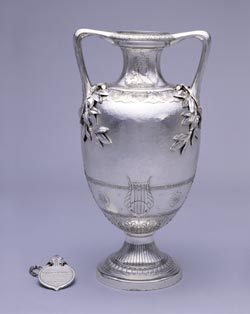|
Background
ABOUT THE ART
Tiffany & Co. (1853- )
Vase and Dedication Medallion, 1877
Silver, 17 ¼ x 9 ½ with handles x 8 ½ in
Bequest of Reuben R. Springer
On May 14, 1878, Cincinnati Music Hall opened its doors in time for the celebration of the third annual Cincinnati May Festival. That evening during intermission, Reuben Springer was presented with a gift of appreciation from the Trustees of the Music Hall Association. The gift presented was the Vase and Dedication Medallion, created by Tiffany & Co. An order for the Vase had been placed a year prior to the completion of Music Hall. It was commissioned by the Chairman of the Music Hall Building Committee and Trustee, Julius Dexter.
The Vase is an amphora-shaped vessel with a narrow neck and two handles. The amphora was a vessel type common to ancient Greek pottery. Through the use of this shape and other elements, which include laurel leaves, the lyre (an attribute of Apollo, the Greek god of music and poetry) and the theatrical mask of Apollo’s muse of tragedy, Melpomene, the vase utilizes Neo-Classical elements, or components that recall the artistic traditions of Ancient Greece and Rome, in its design. It also incorporates Japanese influences, which include the vase’s hand-hammered surface texture, applied ornaments (both are features of traditional Japanese metalwork) and the stylized chrysanthemum (a symbol of the Japanese Emperor).
It is likely that Tiffany’s choice to utilize the hand-hammered texture on the surface of the vase led to the decision to place the dedication inscription on a separate medallion, as to leave the textured surface without interruption. The medallion reads “Presented to Reuben R. Springer to Commemorate the Completion of the Cincinnati Music Hall, May 14, 1878.” It originally hung from one of the handles of the vase.
Like all of Tiffany & Co.’s pieces, this Vase has a pattern number and order number stamped into the underside of its base. These numbers correlate with the numbers found in Tiffany’s records, which reveal the exact date of the piece’s production, the costs incurred to make it and other details regarding its creation. Unfortunately, the identities of the various craftsmen who worked on the piece are unknown.
After Reuben Springer’s death in 1884, the vase was bequeathed to the Cincinnati Art Museum. There, it was received by the Museum’s director, Sir General Alfred Traber Goshorn, also a Trustee of the Cincinnati Music Hall Association and the gentleman who had presented the vase to Springer the evening of May 14, 1878 . 
ABOUT THE COMPANY -- TIFFANY & CO.
In 1837, Charles Lewis Tiffany and John Young traveled from their hometown in New England to New York City in hopes of accomplishing their dream of one day forming a business together. On September 18 of that year, the two opened Tiffany and Young, a stationary and “fancy goods” boutique at 259 Broadway.
Charles Lewis Tiffany renamed the business Tiffany & Co. in 1853. The company became known as a leader in the design of jewelry and luxury goods. In 1848, Tiffany & Co. hired a young German emigrant, Gustav Herter, as its silver designer and added silver flatware and hollowware to its line. Herter’s designs became extremely popular and though he left the company just a few years after his hire, by the mid 1850s Tiffany was recognized as the leading silverware house in New York. The demand and reputation of Tiffany silver continued to soar, and by the close of the Philadelphia Centennial in 1876, they were one of the leading silverware firms in America.
Tiffany & Co., which still operates in New York, maintains their reputation as America’s preeminent house of design and the world’s premier jeweler.

REUBEN SPRINGER AND MUSIC HALL
Throughout Cincinnati’s history, many wealthy patrons supported local institutions of art, music and culture. Among these generous individuals was Reuben Springer. During his life he gave charitably to see cultural institutions, like the Cincinnati Art Museum , succeed. One of his most notable gifts to the people of Cincinnati was the donation of funds toward the building of Cincinnati’s Music Hall.
In 1875, Reuben Springer, a native of Frankfort, Kentucky, and a retired Cincinnati merchant and philanthropist, proposed that a music hall be built. This new music hall was to be constructed to house Cincinnati’s annual music festival, a tradition that continues today as the Cincinnati May Festival. It would also accommodate the city’s annual industrial expositions, which, at the time were the largest in the nation.
In support of the endeavor, Springer made an offer of $125,000 if two conditions were met. The first being that the city provide the lot of land in perpetuity for a small tax-free fee, and second that the citizens of Cincinnati donate the remaining $105,000 needed to realize the building. In the end, the hall cost $300,000, of which Springer donated $185,000. Of the total $115,000 raised by the city, $3,000 of that amount represented the contribution of the city’s school children.
Cincinnati Music Hall opened in May 1878 on the occasion of the third annual Cincinnati Music Festival. The official dedication ceremonies for the hall were held on May 14, and it was on that evening that the Trustees of the Music Hall Association presented Springer with a silver vase and medallion, commissioned from Tiffany & Co. in New York, to demonstrate their appreciation for his support of and dedication to Music Hall and Cincinnati .

|






